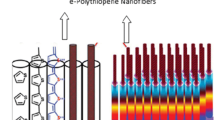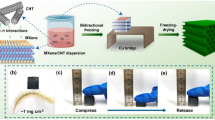Abstract
In this work, a novel activated carbon containing graphene composite was developed using a fast, simple, and green ultrasonic-assisted method. Graphene is more likely a framework which provides support for activated carbon (AC) particles to form hierarchical microstructure of carbon composite. Scanning electron microscope (SEM), transmission electron microscope (TEM), Brunauer–Emmett–Teller (BET) surface area measurement, thermogravimetric analysis (TGA), Raman spectra analysis, XRD, and XPS were used to analyze the morphology and surface structure of the composite. The electrochemical properties of the supercapacitor electrode based on the as-prepared carbon composite were investigated by cyclic voltammetry (CV), electrochemical impedance spectroscopy (EIS), charge/discharge, and cycling performance measurements. It exhibited better electrochemical performance including higher specific capacitance (284 F g−1 at a current density of 0.5 A g−1), better rate behavior (70.7% retention), and more stable cycling performance (no capacitance fading even after 2000 cycles). It is easier for us to find that the composite produced by our method was superior to pristine AC in terms of electrochemical performance due to the unique conductive network between graphene and AC.





Similar content being viewed by others
References
Cakici M, Kakarla RR, Alonso-Marroquin F (2017) Advanced electrochemical energy storage supercapacitors based on the flexible carbon fiber fabric-coated with uniform coral-like MnO2 structured electrodes. Chem Eng J 309:151–158
Candelaria SL, Cao G (2015) Increased working voltage of hexamine-coated porous carbon for supercapacitors. Sci Bull 60:1587–1597
Chen Y, Zhang X, Zhang H, Sun X, Zhang D, Ma Y (2012) High-performance supercapacitors based on a graphene–activated carbon composite prepared by chemical activation. RSC Adv 2:7747–7753
Chen B, Wang Y, Chang Z, Wang X, Li M, Liu X et al (2016) Enhanced capacitive desalination of MnO2 by forming composite with multi-walled carbon nanotubes. RSC Adv 6:6730–6736
Cheng Q, Tang J, Ma J, Zhang H, Shinya N, Qin LC (2011) Graphene and nanostructured MnO2 composite electrodes for supercapacitors. Carbon 49:2917–2925
Choi SH, Kim DH, Raghu AV, Reddy KR, Lee HI, Yoon KS et al (2012) Properties of graphene/waterborne polyurethane nanocomposites cast from colloidal dispersion mixtures. J Macromol Sci, Part B 51:197–207
Demarconnay L, Raymundo-Pinero E, Béguin F (2010) A symmetric carbon/carbon supercapacitor operating at 1.6 V by using a neutral aqueous solution. Electrochem Commun 12:1275–1278
Dong Q, Wang G, Hu H, Yang J, Qian B, Ling Z et al (2013) Ultrasound-assisted preparation of electrospun carbon nanofiber/graphene composite electrode for supercapacitors. J Power Sources 243:350–353
Fritea L, Le Goff A, Putaux J-L, Tertis M, Cristea C, Săndulescu R et al (2015) Design of a reduced-graphene-oxide composite electrode from an electropolymerizable graphene aqueous dispersion using a cyclodextrin-pyrrole monomer. Application to dopamine biosensing. Electrochim Acta 178:108–112
Hassan M, Reddy KR, Haque E, Minett AI, Gomes VG (2013) High-yield aqueous phase exfoliation of graphene for facile nanocomposite synthesis via emulsion polymerization. J Colloid Interface Sci 410:43–51
Hassan M, Haque E, Reddy KR, Minett AI, Chen J, Gomes VG (2014a) Edge-enriched graphene quantum dots for enhanced photo-luminescence and supercapacitance. Nanoscale 6:11988–11994
Hassan M, Reddy KR, Haque E, Faisal SN, Ghasemi S, Minett AI et al (2014b) Hierarchical assembly of graphene/polyaniline nanostructures to synthesize free-standing supercapacitor electrode. Compos Sci Technol 98:1–8
Jiang R, Cui C, Ma H (2013) Using graphene nanosheets as a conductive additive to enhance the capacitive performance of α-MnO 2. Electrochim Acta 104:198–207
Khan MU, Reddy KR, Snguanwongchai T, Haque E, Gomes VG (2016) Polymer brush synthesis on surface modified carbon nanotubes via in situ emulsion polymerization. Colloid Polym Sci 294:1599–1610
Lee YR, Kim SC, Lee H-i, Jeong HM, Raghu AV, Reddy KR et al (2011) Graphite oxides as effective fire retardants of epoxy resin. Macromol Res 19:66–71
Li HY, Yue BY, Yu JG, Wu XW, Zhou WX, Zhou N et al (2016) Diiodocarbene modified graphene: preparation, characterization and its application as a novel adsorbent for aqueous removal of Pb(II). Nanosci Nanotechnol Lett 8:387–392
Lin Z, Waller G, Liu Y, Liu M, Wong CP (2012) Facile synthesis of nitrogen-doped graphene via pyrolysis of graphene oxide and urea, and its electrocatalytic activity toward the oxygen-reduction reaction. Adv Energy Mater 2:884–888
Ma Y, Chang H, Zhang M, Chen Y (2015) Graphene-based materials for lithium-ion hybrid supercapacitors. Adv Mater 27:5296–5308
Marcano DC, Kosynkin DV, Berlin JM, Sinitskii A, Sun Z, Slesarev A et al (2010) Improved synthesis of graphene oxide. ACS Nano 4:4806–4814
Qu Q, Wang B, Yang L, Shi Y, Tian S, Wu Y (2008) Study on electrochemical performance of activated carbon in aqueous Li2SO4, Na2SO4 and K2SO4 electrolytes. Electrochem Commun 10:1652–1655
Reddy KR, Sin BC, Yoo CH, Park W, Ryu KS, Lee JS et al (2008) A new one-step synthesis method for coating multi-walled carbon nanotubes with cuprous oxide nanoparticles. Scr Mater 58:1010–1013
Reddy KR, Sin BC, Ryu KS, Noh J, Lee Y (2009a) In situ self-organization of carbon black–polyaniline composites from nanospheres to nanorods: synthesis, morphology, structure and electrical conductivity. Synth Met 159:1934–1939
Reddy KR, Sin BC, Yoo CH, Sohn D, Lee Y (2009b) Coating of multiwalled carbon nanotubes with polymer nanospheres through microemulsion polymerization. J Colloid Interface Sci 340:160–165
Reddy KR, Jeong HM, Lee Y, Raghu AV (2010) Synthesis of MWCNTs-core/thiophene polymer-sheath composite nanocables by a cationic surfactant-assisted chemical oxidative polymerization and their structural properties. J Polym Sci A Polym Chem 48:1477–1484
Reddy KR, Hassan M, Gomes VG (2015) Hybrid nanostructures based on titanium dioxide for enhanced photocatalysis. Appl Catal A Gen 489:1–16
Shen HH, Hu CC (2016) A high-voltage asymmetric electrical double-layer capacitors using propylene carbonate. Electrochem Commun 70:23–27
Simon P, Gogotsi Y (2008) Materials for electrochemical capacitors. Nat Mater 7:845–854
Su FY, You C, He YB, Lv W, Cui W, Jin F et al (2010) Flexible and planar graphene conductive additives for lithium-ion batteries. J Mater Chem 20:9644–9650
Teng J, Zeng X, Yue BY, Zhao XH, Wang ZH, Yu JG et al (2016) Dibromocarbene modified graphene: preparation, characterization and its application in removal of Pb(II) from aqueous solutions. Nanosci Nanotechnol Lett 8:226–231
Wang ZH, Yue BY, Teng J, Jiao FP, Jiang XY, Yu JG et al (2016) Tartaric acid modified graphene oxide as a novel adsorbent for high-efficiently removal of Cu(II) and Pb(II) from aqueous solutions. J Taiwan Inst Chem Eng 66:181–190
Xu X, Sun Z, Chua DH, Pan L (2015) Novel nitrogen doped graphene sponge with ultrahigh capacitive deionization performance. Scientific Reports 5
Yan J, Fan Z, Sun W, Ning G, Wei T, Zhang Q et al (2012) Advanced asymmetric supercapacitors based on Ni (OH) 2/graphene and porous graphene electrodes with high energy density. Adv Funct Mater 22:2632–2641
Yuan C, Zhang X, Su L, Gao B, Shen L (2009) Facile synthesis and self-assembly of hierarchical porous NiO nano/micro spherical superstructures for high performance supercapacitors. J Mater Chem 19:5772–5777
Zhang L, Zhang F, Yang X, Long G, Wu Y, Zhang T et al (2013) Porous 3D graphene-based bulk materials with exceptional high surface area and excellent conductivity for supercapacitors. Scientific Reports 3
Zheng C, Zhou X, Cao H, Wang G, Liu Z (2014) Synthesis of porous graphene/activated carbon composite with high packing density and large specific surface area for supercapacitor electrode material. J Power Sources 258:290–296
Zhu N, Liu W, Xue M, Xie Z, Zhao D, Zhang M et al (2010) Graphene as a conductive additive to enhance the high-rate capabilities of electrospun Li 4 Ti 5 O 12 for lithium-ion batteries. Electrochim Acta 55:5813–5818
Acknowledgements
We are particularly grateful for the financial support from the National Natural Science Foundation of China (Nos. 21471163 and 51674292), Provincial Natural Science Foundation of Hunan (2016JJ1023), the Hunan Provincial Science and Technology Plan Project, China (No. 2016TP1007) and Project of Innovation-driven Plan in Central South University (2016CX007).
Author information
Authors and Affiliations
Corresponding authors
Ethics declarations
Competing interests
The authors declare that they have no competing interests.
Additional information
Zhi-Hang Wang and Jia-Ying Yang contributed equally to this work.
Rights and permissions
About this article
Cite this article
Wang, ZH., Yang, JY., Wu, XW. et al. Enhanced electrochemical performance of porous activated carbon by forming composite with graphene as high-performance supercapacitor electrode material. J Nanopart Res 19, 77 (2017). https://doi.org/10.1007/s11051-017-3778-x
Received:
Accepted:
Published:
DOI: https://doi.org/10.1007/s11051-017-3778-x




